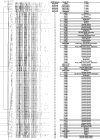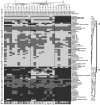Correlation of Lactobacillus rhamnosus Genotypes and Carbohydrate Utilization Signatures Determined by Phenotype Profiling
- PMID: 26048937
- PMCID: PMC4510185
- DOI: 10.1128/AEM.00851-15
Correlation of Lactobacillus rhamnosus Genotypes and Carbohydrate Utilization Signatures Determined by Phenotype Profiling
Abstract
Lactobacillus rhamnosus is a bacterial species commonly colonizing the gastrointestinal (GI) tract of humans and also frequently used in food products. While some strains have been studied extensively, physiological variability among isolates of the species found in healthy humans or their diet is largely unexplored. The aim of this study was to characterize the diversity of carbohydrate utilization capabilities of human isolates and food-derived strains of L. rhamnosus in relation to their niche of isolation and genotype. We investigated the genotypic and phenotypic diversity of 25 out of 65 L. rhamnosus strains from various niches, mainly human feces and fermented dairy products. Genetic fingerprinting of the strains by amplified fragment length polymorphism (AFLP) identified 11 distinct subgroups at 70% similarity and suggested niche enrichment within particular genetic clades. High-resolution carbohydrate utilization profiling (OmniLog) identified 14 carbon sources that could be used by all of the strains tested for growth, while the utilization of 58 carbon sources differed significantly between strains, enabling the stratification of L. rhamnosus strains into three metabolic clusters that partially correlate with the genotypic clades but appear uncorrelated with the strain's origin of isolation. Draft genome sequences of 8 strains were generated and employed in a gene-trait matching (GTM) analysis together with the publicly available genomes of L. rhamnosus GG (ATCC 53103) and HN001 for several carbohydrates that were distinct for the different metabolic clusters: l-rhamnose, cellobiose, l-sorbose, and α-methyl-d-glucoside. From the analysis, candidate genes were identified that correlate with l-sorbose and α-methyl-d-glucoside utilization, and the proposed function of these genes could be confirmed by heterologous expression in a strain lacking the genes. This study expands our insight into the phenotypic and genotypic diversity of the species L. rhamnosus and explores the relationships between specific carbohydrate utilization capacities and genotype and/or niche adaptation of this species.
Copyright © 2015, American Society for Microbiology. All Rights Reserved.
Figures



References
-
- Barraclough T, Balbi K, Ellis R. 2012. Evolving concepts of bacterial species. Evol Biol 39:148–157. doi:10.1007/s11692-012-9181-8. - DOI
-
- Di Cagno R, Minervini G, Sgarbi E, Lazzi C, Bernini V, Neviani E, Gobbetti M. 2010. Comparison of phenotypic (Biolog System) and genotypic (random amplified polymorphic DNA-polymerase chain reaction, RAPD-PCR, and amplified fragment length polymorphism, AFLP) methods for typing Lactobacillus plantarum isolates from raw vegetables and fruits. Int J Food Microbiol 143:246–253. doi:10.1016/j.ijfoodmicro.2010.08.018. - DOI - PubMed
-
- Siezen RRJ, Tzeneva VV, Castioni A, Wels M, Phan HTK, Rademaker JLW, Starrenburg MJC, Kleerebezem M, Molenaar D, van Hylckama Vlieg JET. 2010. Phenotypic and genomic diversity of Lactobacillus plantarum strains isolated from various environmental niches. Environ Microbiol 12:758–773. doi:10.1111/j.1462-2920.2009.02119.x. - DOI - PubMed
Publication types
MeSH terms
LinkOut - more resources
Full Text Sources
Medical
Molecular Biology Databases

